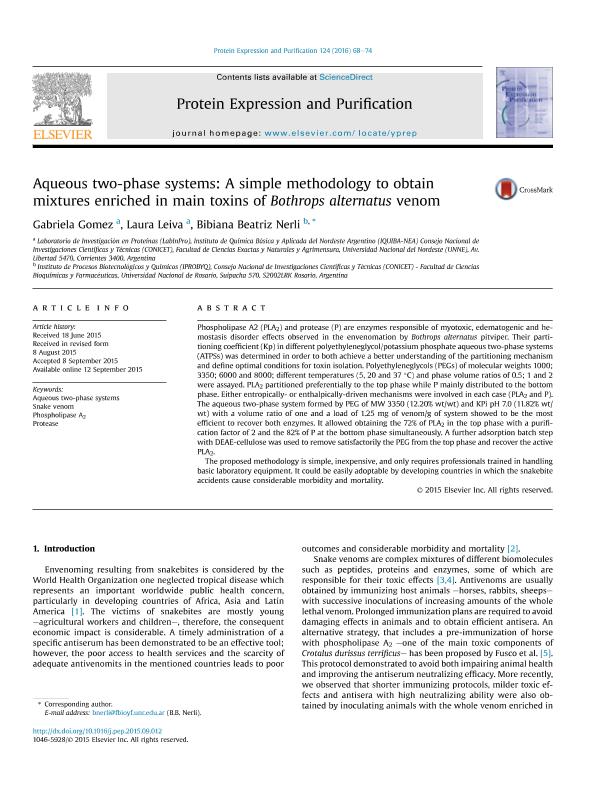Artículo
Aqueous two-phase systems: A simple methodology to obtain mixtures enriched in main toxins of Bothrops alternatus venom
Fecha de publicación:
09/2016
Editorial:
Academic Press Inc Elsevier Science
Revista:
Protein Expression and Purification
ISSN:
1046-5928
Idioma:
Inglés
Tipo de recurso:
Artículo publicado
Clasificación temática:
Resumen
Phospholipase A2 (PLA2) and protease (P) are enzymes responsible of myotoxic, edematogenic and hemostasis disorder effects observed in the envenomation byBothrops alternatus pitviper. Their partitioning coefficient (Kp) in different polyethyleneglycol/potassium phosphate aqueous two-phase systems (ATPSs) was determined in order to both achieve a better understanding of the partitioning mechanism and define optimal conditions for toxin isolation. Polyethyleneglycols (PEGs) of molecular weights 1000; 3350; 6000 and 8000; different temperatures (5, 20 and 37 °C) and phase volume ratios of 0.5; 1 and 2 were assayed. PLA2 partitioned preferentially to the top phase while P mainly distributed to the bottom phase. Either entropically- or enthalpically-driven mechanisms were involved in each case (PLA2 and P). The aqueous two-phase system formed by PEG of MW 3350 (12.20% wt/wt) and KPi pH 7.0 (11.82% wt/wt) with a volume ratio of one and a load of 1.25 mg of venom/g of system showed to be the most efficient to recover both enzymes. It allowed obtaining the 72% of PLA2 in the top phase with a purification factor of 2 and the 82% of P at the bottom phase simultaneously. A further adsorption batch step with DEAE-cellulose was used to remove satisfactorily the PEG from the top phase and recover the active PLA2. The proposed methodology is simple, inexpensive, and only requires professionals trained in handling basic laboratory equipment. It could be easily adoptable by developing countries in which the snakebite accidents cause considerable morbidity and mortality.
Palabras clave:
Aqueous
,
Snake Venom
,
Phospholipase A2
,
Protease
Archivos asociados
Licencia
Identificadores
Colecciones
Articulos(IPROBYQ)
Articulos de INST. DE PROCESOS BIOTECNOLOGICOS Y QUIMICOS ROSARIO
Articulos de INST. DE PROCESOS BIOTECNOLOGICOS Y QUIMICOS ROSARIO
Articulos(SEDE CENTRAL)
Articulos de SEDE CENTRAL
Articulos de SEDE CENTRAL
Citación
Gomez, Gabriela Noemi; Leiva, Laura Cristina Ana; Nerli, Bibiana Beatriz; Aqueous two-phase systems: A simple methodology to obtain mixtures enriched in main toxins of Bothrops alternatus venom; Academic Press Inc Elsevier Science; Protein Expression and Purification; 124; 9-2016; 68-74
Compartir
Altmétricas




